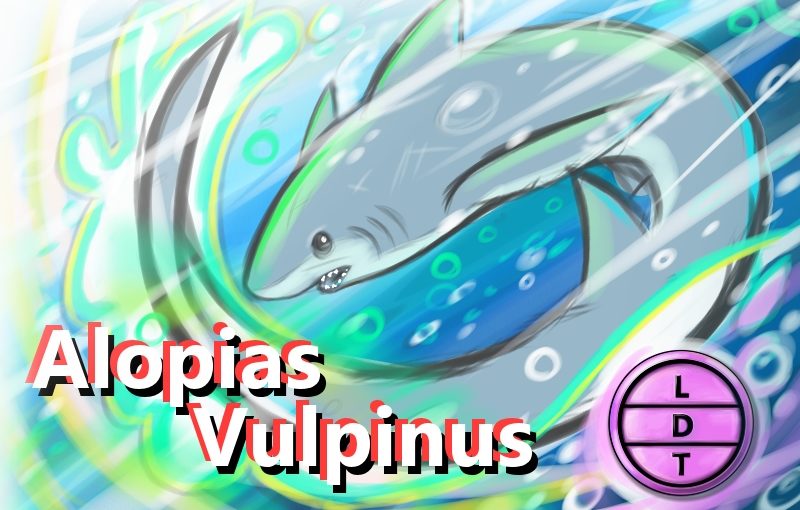“…and today we are talking about a shark that steals a technique from Indiana Jones to get some fishy treasures. But more on that later!”
Intro
The ocean is a great place with lots of room to roam.
The perfect way to escape for the fish that call it home.
“Just stick together and we’ll all be fine,”
The friendly bait fish will chime.
But there’s one who’s a master at the hunting craft,
That captures prey with a whoosh and crack.
The ocean may be great from high to low tide,
But there’s one within its depths from which no fish can hide.
But that’s just the way of the briny sea,
In Life, Death, and Taxonomy
Measure Up
Length – 5 m (16 ft) – If a single shark week could be measured in feet and was 10 feet long, how many thresher sharks would it take to reach the total number of shark weeks, including the most recent 2018 event? Hint: Shark Week originally started in the 80s to promote conservation and correct popular misconceptions about sharks, but later became controversial for heavy dramatization that borders on fiction. Answer: 1.9 threshers
Weight – 230 kg (510 lb) – How many thresher sharks go into the weight of a Mark 48 torpedo, an American heavyweight submarine-launched torpedo (650 lb or 290 kg)? Hint: The torpedo was designed to sink high-powered submarines and ships. Answer: 1.3 threshers
Depths – Can reach 550 m (1,800 ft) – How many depths of Lake Tahoe (1,644) go into a thresher sharks max depth? Hint: Indie rock band Sherwood released a song called Lake Tahoe For My Father on their first full length album Sing, But Keep Going, debuting in 2005… The song recounts memories from writer and guitarist Dan Koch’s childhood visiting Lake Tahoe with his father, but the lyrics take on overall themes of nostalgia and homesickness…. Now that’s deep. Answer: 1.1 Lake Tahoe depths.
Major Fact
- Threshers are typically solitary animals and they hunt alone
- Can sometimes travel in pairs or threes
- Primarily hunt shoaling forage fish
- Forage fish are small species that serve as a primary food source for a variety of ocean predators.
- Also called bait fish or prey fish
- Shoaling refers to fish that travel in groups
- Shoals are helpful for defense and social behavior (mating)
- Schooling is a type of shoaling where fish synchronize swim.
- Schooling can overwhelm predators, making it hard to focus on just one target.
- Called the “predator confusion effect”
- Similar to trying to find a particular spice in the spice isle, called
- inattentional blindness.
- School fish are also harder to catch because multiple prey have multiple eyes.
- Fish have a lateral line organ, which detects movement, vibration, and pressure.
- LLO can be confused by schooling, making group seem like one large fish.
- TL;DR schooling fish are hard to catch, especially by yourself.
- Other predators work together to separate fish from shoals.
- So how does the solitary thresher shark catch hearing and stuff?
- He uses a pokemon move to lower their defense.
- The thresher shark has a unique tailfin with an extra long upper lobe.
- The shark uses its tail to whip prey fish leaving them bewitched, bothered, and bewildered.
- Threshers are fast and could potentially catch prey with decent success in an all out sprint.
- But that’s a lot of energy for one small hearing, plus the chance of missing.
- Whipping can stun multiple prey in a group, increasing the chance of catching several fish in one strike.
- Both direct contact and force generated can stun fish.
- Tip reached 50 mph.
- It’s speculated that the tail whip is powerful enough to split water into hydrogen and oxygen.
- This approach is estimated to be successful 60% of the time.
- The thresher shark can also breach
Outro
Joe: Awwww snap! It’s the end of the episode. That can only mean one thing. It’s time to whip up a call to action. If your a fin of Life, Death, and Taxonomy, leave us a review on iTunes, or wherever you listen to the show!
Carlos: We’re not just fishing for compliments, reviews tell algorithms that people are listening, which helps more people find the show.
Joe: If you have comments questions, or episode suggestions, shoal us some love on Facebook, twitter, or gmail, where we can be found at LDtaxonomy.
Carlos: Thanks for listening! Without you, this podcast would be adrift in the vast digital oceans of the endless internet, derelict with no heading. But each of you is a breeze in our sails, driving us toward the horizon, seeking adventure and treasure in the form of interesting animal info.
Joe: So thank you, you north stars, you finely tuned compasses, you nautical navigational equipment, you fish finders, you sea charts, you topographical maps of the ocean floor, you marine sextants, you south-easterlies, you north easterlies, you’re all the easterlies and westerlies. I don’t know if there are southerlies but you’re those too. Y’all are full on global positioning systems, and it’s just good. Bye bye now.

